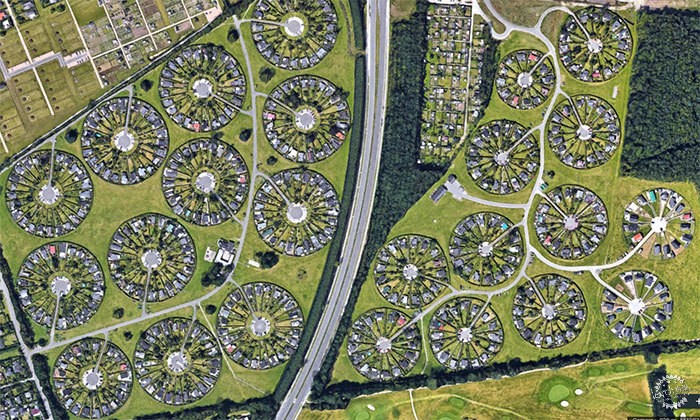
Brønby Haveby, Denmark. © Google Earth
什么是花园城市?
What Are Garden Cities?
由专筑网邢子,小R编译
在工业革命之后,许多欧洲城市人口增长率空前上升,而人们从农村地区迁移到城市地区寻求更好的机会加剧了这种情况。
虽然城市变得更加诱人,但诸如污染和非正规住区的面积增长等问题也更加突出。农村提供了接近自然的机会和丰富的自然资源,但它也有着偏远和就业机会减少的困扰。
鉴于这些问题,在19世纪末,花园城市的概念得以创立。这种城市规划模式的特点是以进步的理想来解决农村逃亡和由此产生的城市地区的无序增长问题,花园城市的概念是基于创建一系列小城市,结合两种环境的优势。
Following the Industrial Revolution, many European cities faced an unprecedented rise in the rate of population growth, intensified by the migration of people from rural areas to urban areas seeking better opportunities.
Although cities became more inviting, problems such as pollution and the growth of informal settlements also intensified. Meanwhile, the countryside provided proximity to nature and an abundance of natural resources, but it also suffered from isolation and a decrease in employment opportunities.
In light of these issues, in the late nineteenth century, the concept of garden cities was created. This model of urban planning was characterized by progressive ideals to solve the problems of rural flight and the resulting disorderly growth of urban areas. The garden city concept was based on the creation of a series of small cities that would combine the advantages of both environments.
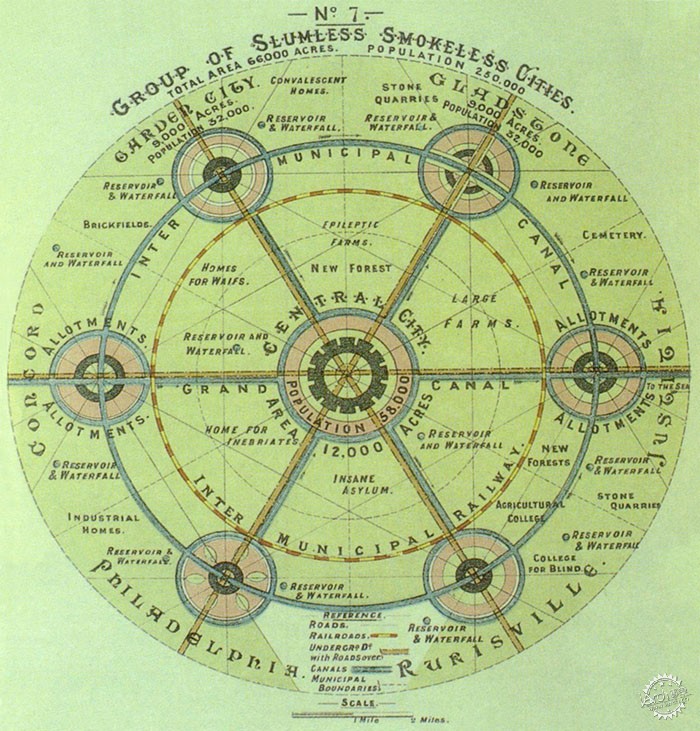
Garden City Map by Howard. Via Wikimedia Commons, public domain
埃比尼泽-霍华德(Ebenezer Howard,1850-1928),在城市化作为一个学术领域建立之前就一直在研究城市,他是花园城市运动背后最有影响力的人。霍华德出版了《To-morrow a Peaceful Path to Real Reform》(1898年)一书,四年后《Garden Cities of Tomorrow》(1902年)重印,他也因此广为人知。
Ebenezer Howard (1850-1928), who had been studying cities before the establishment of urbanism as an academic field, was one of the most influential people behind the garden city movement. Howard published To-morrow a Peaceful Path to Real Reform (1898), a book that was reprinted four years later as Garden Cities of Tomorrow (1902), for which he became widely known.
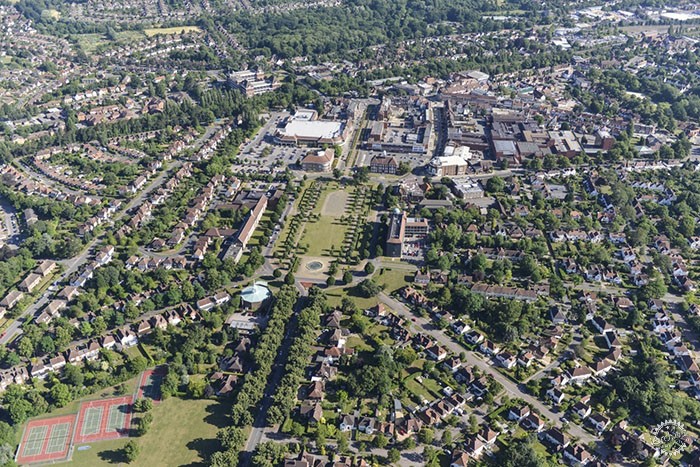
Aerial view of Letchworth. Via RIBA Competitions
除了他的出版物,霍华德还于1899年在英国组织了花园城市协会,在城市规划的背景下推广社会正义、经济效率、美化、健康和幸福的理念。
三块磁铁图,在总结花园城市的理念方面特别具有象征意义,在《Garden Cities of Tomorrow》的两个版本的第一页中都有介绍。每块图示的磁铁代表一个特定的环境:城镇、乡村和城镇-乡村。前两张磁铁列出了城镇生活和乡村生活的积极因素和消极因素,而第三张磁铁则结合了两者的优势。
In addition to his publications, Howard also organized the Garden City Association in 1899 in England to promote the ideas of social justice, economic efficiency, beautification, health, and well-being in the context of city planning.
The Three Magnets Diagram, particularly emblematic in terms of summarizing the ideas of garden cities, is featured in the first pages of both versions of Garden Cities of Tomorrow. Each illustrated magnet represents a specific environment: the town, the country, and the town-country. The first two magnets list the positives and negatives of town life and country life, while the third magnet combines the advantages of both.
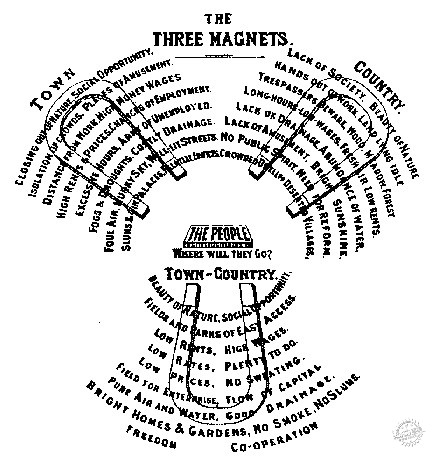
The Three Magnets Diagram, by Ebenezer Howard. Via Wikimedia Commons, public domain
这第三块磁铁包含了花园城市的品质和前景,同时将标题转移到了图的中心,这表明在"人们:他们将去哪里?"这个问题和这种城市规划模式提供的许多优势之间存在着强烈的吸引力。
"在二十世纪初,两项伟大的新发明在我们眼前成形:飞机和花园城市,两者都是新时代的预兆:第一项给了人类翅膀,第二项确保了他在落地后有更好的居住环境"。——Lewis Mumford(1946)
This third magnet contains such promising qualities of the garden city that it shifts the title to the center of the diagram, as opposed to the first two, suggesting a strong attraction between the question The people: where will they go? and the many advantages offered by this model of urban planning.
"At the beginning of the twentieth century, two great new inventions took form before our eyes: the aeroplane and the Garden City, both harbingers of a new age: the first gave man wings and the second promised him a better dwelling-place when he came down to earth." - Lewis Mumford (1946)
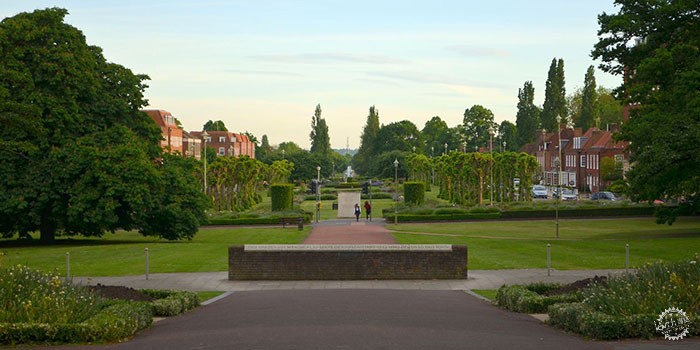
Welwyn Garden City memorial garden. Via Wikimedia Commons, licensed under CC BY-SA 4.0
花园城市的理想化愿景包含具体的乌托邦元素,如按同心圆模式规划的小社区,将容纳住房、工业和农业,周围有限制其发展的绿带。许多图表和地图说明了几个花园城市的集群,这是确保花园城市有效性的一个重要方面。
英国的Letchworth、Welwyn和Stockfeld等城市都是利用这些理念建造的,这一概念在其他国家也有影响,甚至在欧洲之外,很多地区根据不同的地理和历史背景进行了调整和重新诠释。
The idealized vision of the garden city contained specific utopian elements like small communities planned on a concentric pattern that would accommodate housing, industry, and agriculture, surrounded by greenbelts that would limit their growth.
Many diagrams and maps illustrate clusters of several garden cities, which was an important aspect to ensure the effectiveness of the garden cities.
Cities like Letchworth, Welwyn, and Stockfeld in England, were built using these ideas, but the concept was influential in other countries too, even outside Europe, with adaptations and reinterpretations according to different geographical and historical contexts.

Brønby Haveby, Denmark. © Daily Overview
时至今日,这一概念仍经常被重新提起,尽管与最初的想法有很大的不同——提出城市规划的解决方案,试图至少在理论上使城市地区和绿色空间更加融合。
考虑到霍华德的想法和现代城市规划项目之间的理论和概念上的差距,后者无疑更注重研究和理解这些概念的重要性,这些研究也一直持续到今天。
This concept is still frequently revisited to this day - albeit considerably different from the original idea - to propose urban planning solutions that attempt, at least in theory, greater integration between urban areas and green spaces.
But even considering this theoretical and conceptual gap between Howard's ideas and the more recent urban planning projects, the latter certainly highlights the importance of studying and understanding these concepts to this day.
Reference List
HOWARD, Ebenezer. Garden Cities of Tomorrow. London: Swan Sonnenschein & Co. Ltd., 1902.
MUMFORD, Lewis. The Garden City Idea and Modern Planning. In: HOWARD, Ebenezer. Garden Cities of Tomorrow. London: Faber and Faber, 1946.
ROSS, Rebecca; MOGILEVICH, Mariana; CAMPKIN, Ben. Ebenezer Howard's three magnets. The Guardian, 05 December 2014.
|
|
